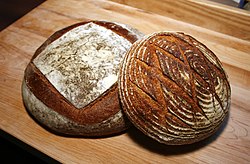Sourdough starter

Two round loaves of naturally leavened (sourdough) bread
|
|
| Type | Bread |
|---|---|
| Main ingredients | Flour, water, sourdough culture, salt |
| |
|
Sourdough bread is made by the fermentation of dough using naturally occurring lactobacilli and yeast. Sourdough bread has a mildly sour taste not present in most breads made with baker's yeast and better inherent keeping qualities than other breads, due to the lactic acid produced by the lactobacilli.
Sourdough is a dough containing a Lactobacillus culture in symbiotic combination with yeasts. It is one of the principal means of biological leavening in bread baking, the others using cultivated forms of yeast. It is important in baking rye-based breads, where yeast does not produce comparable results.
In the Encyclopedia of Food Microbiology Michael Gaenzle writes "The origins of bread-making are so ancient that everything said about them must be pure speculation. One of the oldest sourdough breads dates from 3700 BCE and was excavated in Switzerland, but the origin of sourdough fermentation likely relates to the origin of agriculture in the Fertile Crescent several thousand years earlier [...] Bread production relied on the use of sourdough as a leavening agent for most of human history; the use of baker's yeast as a leavening agent dates back less than 150 years."
Pliny the Elder described the sourdough method in his Natural History:
Generally however they do not heat it up at all, but only use the dough kept over from the day before; manifestly it is natural for sourness to make the dough ferment... (Nat. His. 18:26 §104)
Sourdough remained the usual form of leavening down into the European Middle Ages until being replaced by barm from the beer brewing process, and then later purpose-cultured yeast.
Bread made from 100% rye flour, popular in the northern half of Europe, is usually leavened with sourdough. Baker's yeast is not useful as a leavening agent for rye bread, as rye does not contain enough gluten. The structure of rye bread is based primarily on the starch in the flour, as well as other carbohydrates known as pentosans; however, rye amylase is active at substantially higher temperatures than wheat amylase, causing the structure of the bread to disintegrate as the starches are broken down during cooking. The lowered pH of a sourdough starter, therefore, inactivates the amylases when heat cannot, allowing the carbohydrates in the bread to gel and set properly. In the southern part of Europe, where panettone was originally made with sourdough, sourdough has become less common in recent times; it has been replaced by the faster-growing baker's yeast, sometimes supplemented with longer fermentation rests to allow for some bacterial activity to build flavor.
...
Wikipedia
